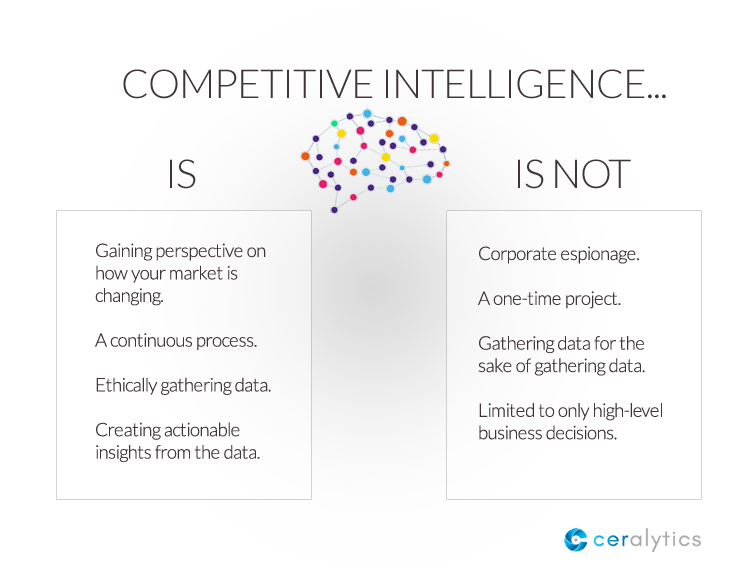Competitive intelligence is the key to successful marketing and business strategies.
Why then, when it comes to content marketing, is incorporating competitive intelligence either overlooked or never even considered?
Think about your own content strategy. What are the strengths and weaknesses in your competitors’ content and positioning? What topics perform well for them that you currently have deficiencies? What differentiators do you have that should be seized (if you aren’t already)? If you can’t answer these questions yet, you’re not alone.
There is a lot of great content marketing strategy advice out there – as the thought leaders in the space know how to walk the talk. However, when doling out advice on content strategy, competitive intelligence is often left out.
When doling out advice on content strategy, competitive intelligence is often left out. Click To Tweet
Take these two articles for example: Content Marketing Institute (whom we love) has a great quick-hit guide to content marketing strategy. Notice that of the 5 components, none of them revolve around competitors, and only one even mentions competition at all. Moz (whom we also love) also has a content marketing strategy article for beginners. Again, notice that there isn’t even mention of competitor intelligence or analysis. These two articles rank highly for “content strategy” and are written by very well respected publishers. So why is competitive intelligence left out? Let’s explore.

Even the best in the industry sometimes overlook something obvious.
What it is competitive intelligence?
Competitive intelligence is identifying and gaining a perspective on how your market is changing. It’s keeping the pulse on the industry and identifying current and potential shifts so you can adjust your strategy to the changing market conditions.
Note what competitive intelligence is NOT. It’s NOT corporate espionage. It’s NOT just getting a bunch of data and calling it a day. It is NOT a project that’s done one time and then forgotten.
Competitive intelligence IS about ethically collecting the right data in relation to your goals and making actionable insights from it on a continuous basis.
Competitive intelligence IS also about the industry as a whole AND your individual competitors.
 Many times, organizations fixate on one competitor and miss huge trends that come from smaller players who see success in new trends and positioning. If you’re constantly looking through binoculars to keep tabs on your competition across the way, you’re going to miss the opportunities and threats that come up beside, behind, and under you.
Many times, organizations fixate on one competitor and miss huge trends that come from smaller players who see success in new trends and positioning. If you’re constantly looking through binoculars to keep tabs on your competition across the way, you’re going to miss the opportunities and threats that come up beside, behind, and under you.
Keeping the pulse of the entire industry allows organizations to spot these new opportunities and threats, and adjust their strategy.
 Where competitive intelligence is used frequently
Where competitive intelligence is used frequently
Competitive intelligence is an essential component to successful business strategy. Getting an understanding of the market, the players in the space, the pricing of each competitor, expected margins, etc. are all essential in developing a business plan that can succeed. Often, a lot of work goes into competitive intelligence early in the formation of a company. After all, companies that haven’t been formed yet don’t have much other data to go on other than what’s currently happening in their market.
When competitive intelligence takes a backseat
Once companies have been in an industry for a while, the emphasis on competitive intelligence gives way to internally-focused biases. The likeliest causes of this shift are the high price of competitive intelligence projects (most are very time and resource intensive), internal egos (we all have them, let’s not lie) of employees and stakeholders who have seen a lot of the industry and feel they know it as well as anyone, and the focus on the company’s own data it accumulates through its own sales, marketing and client service teams.
It seems almost natural for companies to then start focusing on their own experiences (and thus own biases) after starting with so much external data. However, when the trend of using less external data in favor of more internal data goes too far, companies lose sight of their industry and customer’s needs because they are only seeing how their audience interacts with THEM and not how their audience interacts with the industry as a whole or with EACH competitor.

Source: happyjar.com
The result: organizations become too narrowly focused and miss out on big trends as they are happening. Even missing small trends in the industry hurts organizations and their ability to reach new audiences that may have been a great fit for their offerings. Often times it takes downturns in sales to raise the red flag that more insights about the market are needed, and by this time the company is already on a downward trend. Competitive intelligence needs to happen regularly to keep this trend from happening in the first place.
The problem with being too internally focused
When content strategies are created, many are done after the business’s initial focus on external data. The subsequent content strategies are thus built on internally driven factors, such as existing content, what the organization already knows about their audience, what their marketing funnel looks like for existing audiences, and the goals they want to accomplish. While these factors are great to use, they do not provide a complete picture of the target audience and industry.
Also, as marketers seek resources to create new content, looking internally is a great means of tapping talent and knowledge about certain subject areas. These internal resources can be fantastic at writing about a myriad of topics that are relevant to your audience. But over-reliance on them often turns into tunnel vision. Content marketers fall into the common trap of focusing on what can be created by their internal resources instead of what needs to be created.
Content creators may be inwardly focused on what CAN be created instead of what SHOULD be created. Click To TweetContent creators need direction and a two-way conversation with marketing about what’s resonating in the industry. While the other internal factors play pivotal roles in content strategy, they miss large opportunities overall and represent an incomplete picture. The result is content strategies that struggle or fail despite the best efforts of their sponsors.
What content strategies without competitive intelligence fail to do:
- Spot new trends happening in the industry
- Uncover the content that is currently working for competitors
- Identify the language used by your industry instead of language used by your company
- Reveal content that competitors have written about with great success but have under-utilized
- Identify competitor positioning against your own offerings
These are large gaps in a content strategy, and competitors who are utilizing their own competitive intelligence will have many of these insights on your organization – giving them a leg up on you. You need to level the playing field or take the lead with your own ongoing competitive intelligence.
Why ongoing competitive intelligence is the key to a great content marketing (and business) strategy
Competitive intelligence identifies customer needs you missed in your content marketing strategy and emerging customer needs that your competition has recognized but you have not.
Great content marketing strategies incorporate these insights continuously so the marketing team is always up-to-date on what is happening in the industry and where opportunities and risks are before they become obvious through a lack of results (i.e., competitors taking your market share). It provides a clearer picture of reality instead of what can be a biased, dated, or limited view of the market.
Competitive intelligence provides the REALITY of your market instead an internally BIASED view. Click To TweetMoving these insights up the chain, content marketers can then raise red flags to senior stakeholders about changing trends, topics, language and offerings in the competitive space before they become emergencies. These insights can then be used by other facets of the business, such as product development, sales, customer support and more.
How you can use competitive intelligence in your content marketing strategy
Today, marketing strategies may seem secretive, but in reality they are wide open to the public. The content you and your competitors create and publish exposes your positioning, tactics and underlying strategy to anyone with the right tools to analyze it.
Many times this analysis is done manually – content audits of competitor sites and social channels – but because it’s manual, and therefore very resource intensive, it is often only done once a year at most. It takes a massive investment of time and money, hence many organizations don’t bother.
Competitive intelligence software enables organizations to quickly identify the topics, trends, and positioning of each competitor and the industry as a whole – in near real-time, giving you continuous insights into your industry. As we’ve explored, these insights are invaluable to not only your content strategy but to your overall business.
The role of content marketing (and business) is to provide value to its audience. Unless you are actively listening to what your audience wants by listening to the industry as a whole, you will miss significant opportunities on which your competition will capitalize. Don’t get left behind.
Next steps
See how competitive intelligence fits into the 7 essential steps of any great content strategy.
Photo via Visual hunt


